The Mysterious OrienetPrepared by Harold Stephens
Travel Correspondent for Tha Airways International
The mysterious Orient! Black Magic! Spells! Witch doctors? Elusive natives of the rain forest! Jungle giants? Lost Cities! The mysteries of the Far East!
What are these phenomena associated with the East? Do we accept the premise that such mysteries exist, and if we do, are they real, or imagined? Is not Southeast Asia, really, a mood, a mood that’s to be felt and not necessarily understood?
No adventure in the Southeast Asia would be complete without some involvement with the so-called ‘mysteries of the Orient.’ I remember when I was quite young I read a Somerset Maugham short story about an Englishman who had spent a lifetime running a rubber estate in Malaya. When the time came for him to retire, he packed his bags, boarded a steamer and set sail for England. Behind he left not only a way of life but also a Malay woman with whom he had spent most of his years in the East. The woman was not too pleased with his departure, so she had a bomoh, a Malay witch doctor, put a curse on him. The unfortunate Englishman died from hiccups before he reached England.
It was a fascinating story, but a bit ridiculous. How could someone put a curse upon someone else, and have him die of hiccups? It was all part of Maugham’s imagination. But when I came to Asia, I learned that the noted English writer had travelled widely throughout the Malay States and from his everyday experiences he drew the plots for his stories. The stories were more real than imagined. I also discovered that some very strange things do go on in Asia, and I learned that if you want to survive in this part of the world, you cannot let yourself become a diehard skeptic, or even a doubter. You soon learn to accept those mysteries that once may have baffled you. You may not totally believe them, but you accept them.
The learning process is slow. It doesn’t happen in a week or a month, or even in a year. But it does happen, eventually, if you remain in Asia long. It begins when you go to a Thaipusam celebration at the Batu Caves in Malaysia, and see things performed by Hindu devotees which even in your wildest imagination you never thought humanly possible. Or when you travel to the Philippines during the Easter holidays, and on Sunday morning visit Batangas outside Manila and watch believers being nailed to a cross, and later see them kneeling in church praying. And when you hear and perhaps visit with a bomoh, or a soothsayer or rain-stopper, or a medium or faith-healer, you know it’s all an inherent part of the mysterious Orient.
Anyone who spends time in Malaysia is certain to hear village tales about bomohs, but it isn’t always restricted to villages. Bomohs travel in royal and government circles and they play an integral role in Malay society.
The main task of a bomoh is healing. By autosuggestion he falls into a trance and spirits speak through his words. The results achieved by these bomohs have baffled doctors and scientists the world over.
Perhaps the most famous, or at least the most publicized, bomohs in Malaysia are the rain-stoppers. Many countries profess to have rain-makers, but few have rain-stoppers. The event can be a very serious affair.
A famous woman bomoh was engaged to keep rain away during a royal wedding. It seems it had rained continuously for a week before the wedding, and finally the royal family engaged Che Lamah, known for her ability to stop rain. For five days, without bathing, she kept up incantations during the ceremony. For the five days, throughout the wedding, the weather was fine.
Bomohs are also skilled, it’s said, in the art of preparing charms to engender love, beauty and courage, to protect against spiritual or material hurt, to prevent girls from marrying rivals, to obtain good business, to shatter a competitor’s business, and so forth. Name it and a bomoh can probably do it.
But it’s not always easy. In preparing certain charms, especially love charms, the potion must be mixed with blood— blood from the corpse of a person who has died violently.
Or suppose you discover your cup of tea is poisoned, and you have already drunk from it. A good bomoh will recommend the following: take two dry walnuts, some clean figs, twenty leaves of rue, and ‘bruise’ and beat together with a dash of salt and seven different kinds of flowers. Take orally immediately.
Another antidote for poison, if the above doesn’t work, is burnt tigers’ whiskers in coconut oil, which must be licked from a betel leaf. This can also be taken as an internal remedy for chronic rheumatism.
Live in Southeast Asia long enough and you learn anything is possible. What about Big Foot? Would you believe Southeast Asia has a “yeti,” the legendary Big Foot.
When I become involved in conversations about such subjects, I find that the talks usually ends in a stalemate. I've learned that, as with religion and politics, it's best to avoid such controversial subjects. But, of course, this is not always possible, especially when it come to the subject of Southeast Asia's 'yeti', the legendary Big Foot. I believe my reasoning is justified. I found Big Foot footprints in the Malay jungle some years ago.
In the spring of 1970, Kurt Rolfes, an ex-combat photographer, and I were invited by Tunku Bakar, a Malay prince from Johor State, to join him and some friends on a fishing trip on the Endau River in Malaysia. The monsoon rains came early that year and instead of finding good fishing we were forced us to seek shelter in a native village. For three wet, uncomfortable days we listened to Bakar translate tales of the jungles the natives had to tell. Then casually the headman said: “We saw the footprints again.”
“What footprints?”
“The giant people—orang dalam. .”
“Above the twelfth rapid beyond the Kimchin,” the man told us. Another jungle superstition I thought at the time.
A couple months later in Singapore that a Chinese friend told me about an incident that he had that made me change my mind. One night when he was driving along a lonely road in Malaysia the cars before him were stopped. They has seen a hairy creature run across the road. It had been reported in the newspaper.
I checked the paper, and others. Such sightings were not new. In one case a young Chinese girl was tapping rubber trees on an estate when she felt a hand on her shoulder and turned to be “confronted by the most revolting female” one could possibly imagine. This she-thing was covered with hair, had white Caucasoid-type skin and long black hair.
The estate manager called Security and when guards arrived they too saw the creature. The following day, a Hindu worker reported seeing a human-like beast on the same river bank.
There were dozens of such reports, all documented. But did these have any direct relationship with what the natives on the Endau River had to tell me? Kurt and I studied maps of the river. We located the village where we stayed and followed the river up to the rapids. I counted them—twelve. The headman said there were twelve rapids that led to the Kimchin.
It was more than coincidence. The headman had other things that confirmed what I had read. We went as far as we could with the research. There was only one way left, to organize an expedition and go into the jungle.
It took better part of a year and with the funding of an American magazine Kurt and I were back. We had a Eurasian and two native guides to accompany lead, and Captain Patrick Coverton of the Second King Edward VII's Own Gurkha Rifles and a squad of his men to lead us to the first rapids. We were then on our own.
Our five-meter-long boat, when fully loaded, was centimeters above the water. We had a six-horsepower outboard that took us part of the way up the river to shallow water. After that we took turns at the paddles.
The lower Endau is wide and muddy, and swampy along the banks. Here crocodiles lurk among the reeds. Above the rapids there are few mud banks and very few crocodiles, so we could swim with reasonable safety. Often we pushed the boat along using it only to carry our supplies. At best we could do sixteen kilometers a day.
We passed beyond the tributary of the Kimchin and continued up the Endau. A few days later we reached the twelfth rapid above the Kimchin. Just before dark we found a wide sand bank, a good place to set up camp. While the others were busy gathering firewood, Kurt and I crossed the river to the other bank to look for tracks. All along the sand bank were elephant tracks with fresh droppings, and numerous tiger tracks.
Kurt was in the lead, stopping often to check each track carefully. Suddenly he stopped and spread out his arms. He stood motionless, staring down at the crusted sand. I cautiously moved up to where he stood. There in front of us were footprints, human footprints, though not ordinary ones. They were enormous, 45 centimeters long and twenty centimeters wide. The creature that had made them had come down from the jungle and entered the water and here the tracks disappeared.
Kurt photographed the footprints and we wanted to follow where they came from but our guides would have none of it. They wanted to return down river. Our discovery hit the press and appeared as a cover story in Argosy magazine in the US. Our problem now was confronting the skeptics. Had we created a hoax. All I can do is tell you something about the so called 'Orang dalam.'
The size of the man-beast varies. He is described as being anything from two to three meters tall. All agree that he is hairy but not furry. Males have much hair about their head, chest, arms and legs. Their eyes are red, or at least bloodshot. And all reports claim they give off a powerful odor which our guides likened to 'monkey urine".
Another interesting characteristic about the creatures is that, at first contact, they appear to be friendly. They usually make the overtures and approach slowly. Then, for some reason, they become frightened and flee into the jungle.
The search in Southeast Asia has reached a standstill, but in south China there have been so many sightings that the Chinese have set up a bureau called the “Society for the Survey and Research of the Chinese Wild Man.” There they call Big Foot “ye ren.”
That’s Big Foot, and then there are Stone Age tribes living in the Southern Philippines and the elusive Punans in the jungles of Borneo.
And what about the Lost Tribes of Burma and the “bloodless” doctors of the Philippines, or faith healers as they call them. And there’s more, so much more. Loch Ness-type monsters living in a lake deep in the Malay jungle, and a lost sunken city beneath another jungle lake. To search them all out you have to dawn a fedora and become another Indiana Jones. It’s all document and in history books. That’s the excitement of Southeast Asia--its mysteries.
A few years ago, Thai Airways sponsored by book Return to Adventure Southeast Asia in which I wrote about jungle giants and lost cities and many more mysteries of Southeast Asia. For those who want a discounted copy of the book, contact www.wolfendenpublishing.com. and I will post autographed copies from Bangkok.
Harold Stephens
Bangkok
E-mail: ROH Weekly Travel (hstephens_1@yahoo.com)
Note: The article is the personal view of the writer and does not necessarily reflect the view of Thai Airways International Public Company Limited. | 
NEGRITO ON RAFT | | 
BIG FOOT PRINT | | 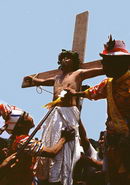
CRUX PHILIPPINES | | 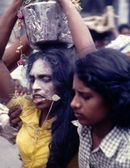
MALAYSIA THAIPUSAM | | 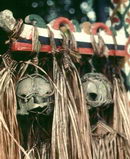
BORNEO HEADS | | 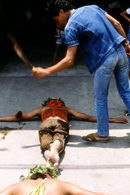
FLOGGING | | 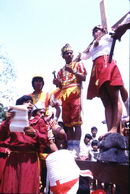
GIRL ON CROSS | | 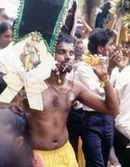
HINDU FESTIVAL | | 
MALAYSIA KELLIE'S 2 |
|





